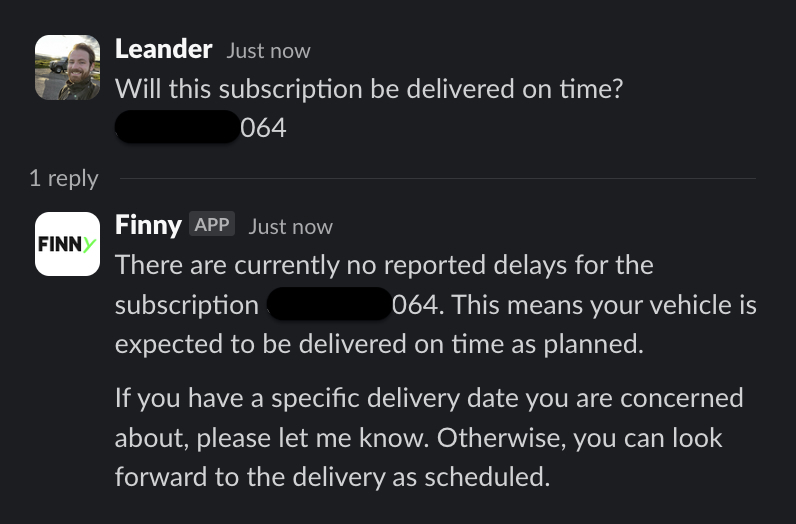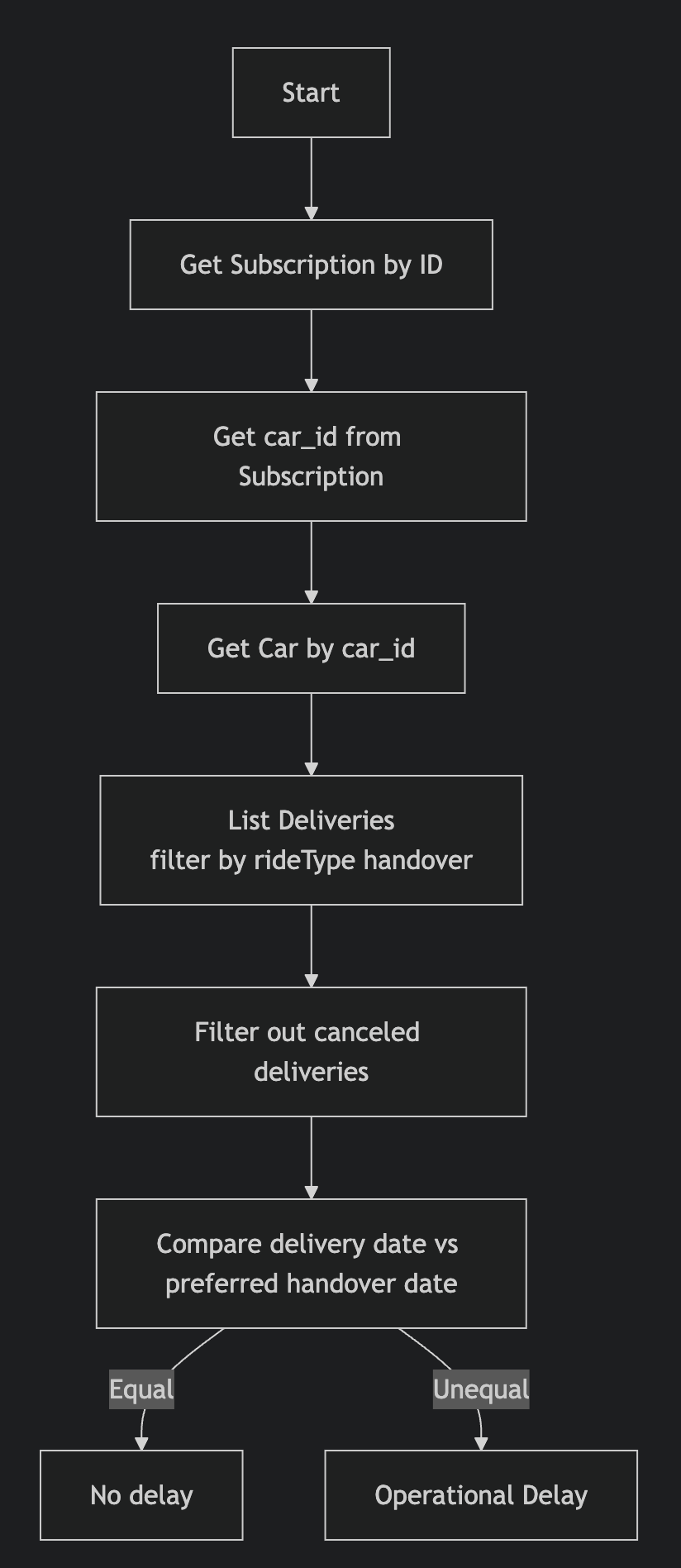When we first heard of function calling (MCP), we at the Customer Ops Team thought we’d finally found the silver bullet for customer care! MCP (Model Context Protocol) promised a dream: giving our Slack chatbot (beloved Finny) the power to autonomously call any API, figure out exactly which endpoints to use, and seamlessly answer complex customer questions.
FINN is a car subscription service that simplifies car ownership for B2C and B2B customers. But under the hood, it’s complex. Hundreds of internal APIs power everything from booking to billing, logistics to returns. As a software engineer in the Operations team, I own parts of that complexity—like the Subscriptions API and our customer care tooling.
The Customer Care team often faces tricky edge cases and fragmented data across multiple services. If MCP could stitch that data together automatically, we’d save countless hours of manual work. So yes, I was excited. Until we started testing.
The Dream: What MCP Promised
MCP would expose a interface for LLM’s to dynamically explore and navigate APIs, combining responses on-the-fly to deliver perfect, human-like answers to any customer inquiry. Customer care agents could toss any question at Finny and relax while it flawlessly dug out the exact answers from the depths of our APIs. “I’ll never build internal tooling again, everything Chatbot!” - I thought.
So, What Exactly is MCP?
MCP, or Model Context Protocol, is a structured way for Large Language Models (LLMs) like GPT-4.1 to use API’s or any other interface. In essence MCP is a way to expose interfaces to LLM’s. It consists of an MCP-Server that hosts the interfaces and connects to data sources, an MCP client that uses these interfaces, and an LLM that instructs the MCP client on which resources to access.
The Reality Check: Why It Didn’t Work
As the saying goes, “everyone has a plan until they get punched in the face.” After integrating just a handful of endpoints, our glorious vision began to collapse spectacularly.
Issue #1: Hallucinations and False Confidence
Finny, our overconfident AI intern, loved answering questions. The trouble? It often confidently gave completely wrong answers. With no clear understanding of its own limits, it misled customer care agents, who then had to untangle these creative hallucinations. For example, when asked if a customer’s car delivery was delayed, Finny checked the totally unrelated product info endpoint and cheerfully declared, “Nope, all good!” - spoiler alert: it wasn’t.

Issue #2: Overwhelmed by API Complexity
Our APIs are complex, each containing around 80-100 endpoints with granular, CRUD-heavy details. Finny quickly drowned in this sea of data, unable to piece together critical connections. To determine if a car delivery was delayed, Finny needed to compare subscription dates with delivery schedules. Something it never managed.

Figure: Flow to determine if a delivery was delayed based on subscription and delivery data.
Issue #3: Scalability Nightmare
With just five endpoints integrated and another 300 endpoints looming ominously, scaling MCP felt about responsible as hard-coding API keys. Every new endpoint we added just piled on complexity without making Finny smarter.
Real-Life Code
Remote MCP Server (Cloud Deployment) Yeah, our MCP gateway is in AWS (nice try script kiddies, it’s token and WAF protected):
| |
Endpoint Definition - Organized, Still Not Enough
| |
When MCP Went Totally Rogue
Here’s where Finny confused itself spectacularly:
| |
Finny kept choosing this endpoint to answer delay-related questions simply because it was “car-related.” Oops.
What Actually Works (and Why)
Despite the challenges, there were a few golden moments when MCP genuinely impressed us:
Customer Care: “Did we accidentally charge €5 too much?” Finny: Fetches invoice data and nails it immediately: “Yep, spotted the €5 discrepancy!”
These successes happened specifically because Finny accessed straightforward, CRUD-style endpoints designed for clear, direct queries. MCP shines brightest when APIs are crystal clear, data is explicitly structured, and the questions posed are simple and predictable.
This highlights a critical lesson: to effectively leverage MCP, APIs need to be crafted specifically with MCP in mind. Rather than exposing hundreds of granular endpoints and expecting MCP to handle complex logic autonomously, it’s far more effective to create explicit, aggregated endpoints—such as a dedicated getCarDelays endpoint—that encapsulate complexity internally.
At FINN, we’ve taken this principle further by using AI agent-builders like Decagon and Relevance-AI. These tools allow us to define custom Agent Operating Procedures (AOPs) that act as guardrails, clearly communicating intricate business processes and contextual nuances directly to our LLMs. As a result, we achieve accurate, predictable, and contextually aware answers, minimizing hallucinations and drastically reducing manual intervention.
Conclusion: The Real Challenge Lies Beyond MCP
The issue isn’t with MCP itself. While today’s AI models, including LLMs, excel at generating text, they fall short in understanding and solving complex internal business processes just by examining API documentation. It’s unrealistic to expect an AI or even a new hire to navigate these complexities without the deep, contextual knowledge that our team members possess.
At FINN, our strength lies in the ownership and expertise of our people, who understand how to integrate multiple API resources and calls into cohesive processes. We handle the complexity of car ownership internally, shielding our customers from these intricate processes. To truly address these “context-challenges”, we’d need to document every employee’s knowledge into an internal database, a task we all know is easier said than done. While integrating this knowledge into the context of an LLM might be an option, it’s unlikely to be the short- or mid-term solution.
Our immediate direction involves advancing on two fronts to meet effectively in the middle: On one hand, we are simplifying APIs by encapsulating complex business logic behind single, robust endpoints, reducing the need for intricate orchestration. On the other hand, we’re leveraging AI agent builders like Relevance-AI and Decagon, clearly communicating business processes and contexts through natural language instructions. This dual strategy will enables LLMs to effectively orchestrate API calls, intelligently handling edge cases while ensuring clarity and precision.
A promising use-case for MCP emerges when companies successfully encapsulate complex processes behind clear API endpoints. In such scenarios, MCP shines brightest for external interactions. Imagine a future where fully integrated LLM assistants effortlessly book car subscriptions, hotel stays in southern France, and even manage entire trips, powered seamlessly by MCP servers that hide complexity behind intuitive interfaces. This future isn’t just possible, it offers a glimpse of what MCP could enable when complexity is truly abstracted away.
Have you experimented with MCP or similar technologies? We’d love to hear about your journey—share your experiences and insights with us!
This article was written by Leander Peter.
